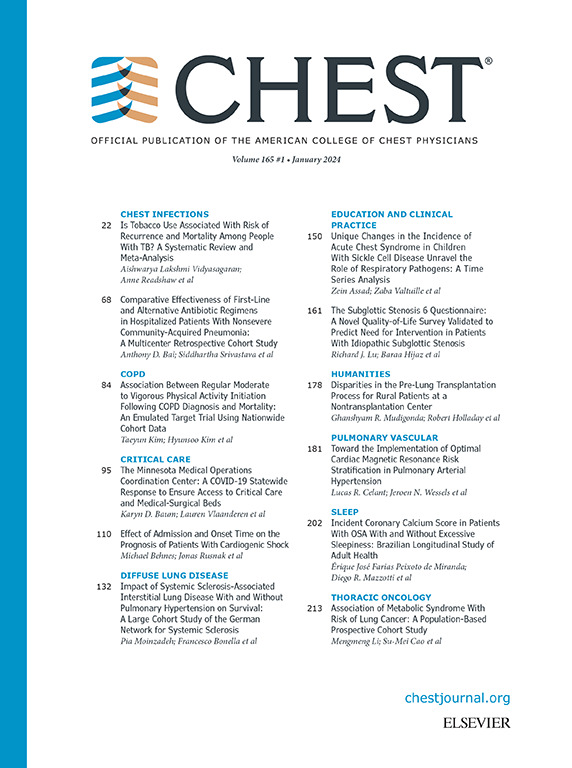Lung Cancer Risk in Preserved Ratio Impaired Spirometry and Airway Obstruction: A UK Biobank Study.
IF 8.6
1区 医学
Q1 CRITICAL CARE MEDICINE
引用次数: 0
Abstract
BACKGROUND Preserved ratio impaired spirometry (PRISm) has emerged as a distinct pulmonary pattern with potential clinical significance, but its association with lung cancer risk remains unclear. RESEARCH QUESTION This study compared the risk of incident lung cancer among individuals with PRISm to that among those with normal spirometry and chronic obstructive pulmonary disease (COPD). STUDY DESIGN AND METHODS We analyzed data from 267,222 UK Biobank participants who underwent spirometry at baseline and had no history of cancer before enrollment. Lung function was categorized as normal, PRISm (FEV1/FVC ≥ 0.70 and FEV1 < 80% predicted), mild COPD (FEV1/FVC < 0.70 and FEV1 ≥ 80%), and moderate-to-severe COPD (FEV1/FVC < 0.70 and FEV1 < 80%). Incident lung cancer cases were identified through linkage to national cancer registries. Cox proportional hazards and Fine-Gray competing risk models were used to estimate hazard ratios (HRs) and subdistribution hazard ratios (sHRs), adjusting for confoundings. RESULTS During a median follow-up of 13 years, 2,058 incident lung cancer cases were identified. In multivariate models, the adjusted HR for lung cancer was 1.59 (95% CI 1.38-1.82) in the PRISm group, 1.75 (95% CI 1.51-2.02) in mild COPD, and 2.92 (95% CI 2.62-3.25) in moderate-to-severe COPD, compared to that among individuals with normal spirometry. Results from the competing risk model were consistent, with an sHR of 1.55 (95% CI 1.35-1.79) in PRISm. INTERPRETATION PRISm is independently associated with an increased risk of lung cancer. It is necessary to improve risk stratification and potential early screening strategies in PRISm populations. CLINICAL TRIALS REGISTRATION NA.保存比例受损肺活量和气道阻塞的肺癌风险:一项英国生物库研究。
保留比例肺功能受损(PRISm)已成为一种独特的肺模式,具有潜在的临床意义,但其与肺癌风险的关系尚不清楚。研究问题:本研究比较了PRISm患者与正常肺活量和慢性阻塞性肺疾病(COPD)患者发生肺癌的风险。研究设计和方法我们分析了267,222名英国生物银行参与者的数据,这些参与者在基线时接受了肺活量测定,在入组前没有癌症史。肺功能分为正常、PRISm (FEV1/FVC≥0.70,FEV1 <预测值80%)、轻度COPD (FEV1/FVC < 0.70, FEV1≥80%)、中重度COPD (FEV1/FVC < 0.70, FEV1 < 80%)。通过与国家癌症登记处的联系,确定了肺癌病例。Cox比例风险和Fine-Gray竞争风险模型用于估计风险比(hr)和亚分布风险比(sHRs),并对混杂因素进行调整。结果在中位13年的随访期间,共发现2058例肺癌病例。在多变量模型中,与肺量测定正常的个体相比,PRISm组肺癌的校正HR为1.59 (95% CI 1.38-1.82),轻度COPD为1.75 (95% CI 1.51-2.02),中重度COPD为2.92 (95% CI 2.62-3.25)。竞争风险模型的结果一致,PRISm的sHR为1.55 (95% CI 1.35-1.79)。prism与肺癌风险增加独立相关。有必要改进PRISm人群的风险分层和潜在的早期筛查策略。临床试验注册
本文章由计算机程序翻译,如有差异,请以英文原文为准。
求助全文
约1分钟内获得全文
求助全文
来源期刊

Chest
医学-呼吸系统
CiteScore
13.70
自引率
3.10%
发文量
3369
审稿时长
15 days
期刊介绍:
At CHEST, our mission is to revolutionize patient care through the collaboration of multidisciplinary clinicians in the fields of pulmonary, critical care, and sleep medicine. We achieve this by publishing cutting-edge clinical research that addresses current challenges and brings forth future advancements. To enhance understanding in a rapidly evolving field, CHEST also features review articles, commentaries, and facilitates discussions on emerging controversies. We place great emphasis on scientific rigor, employing a rigorous peer review process, and ensuring all accepted content is published online within two weeks.
 求助内容:
求助内容: 应助结果提醒方式:
应助结果提醒方式:


